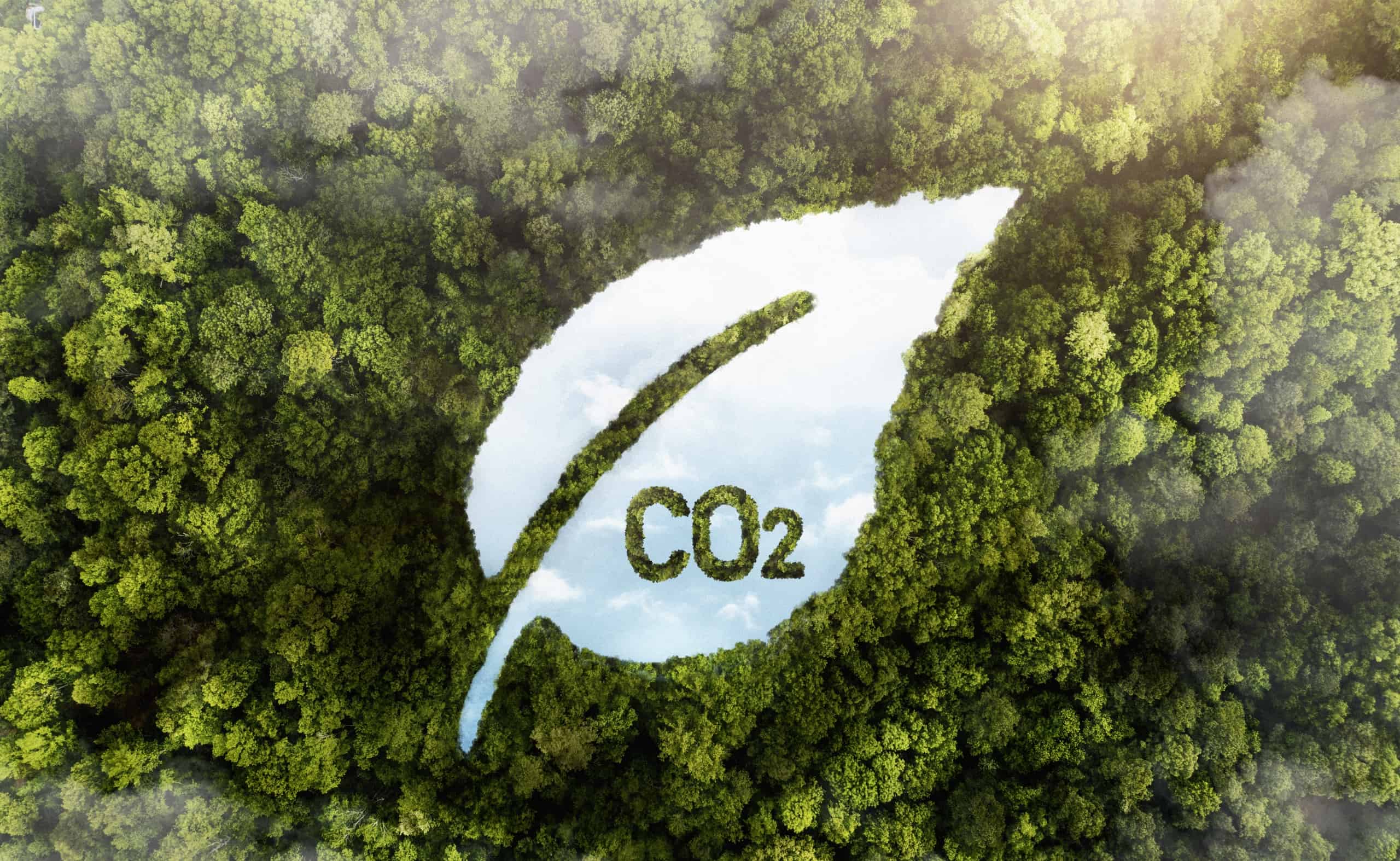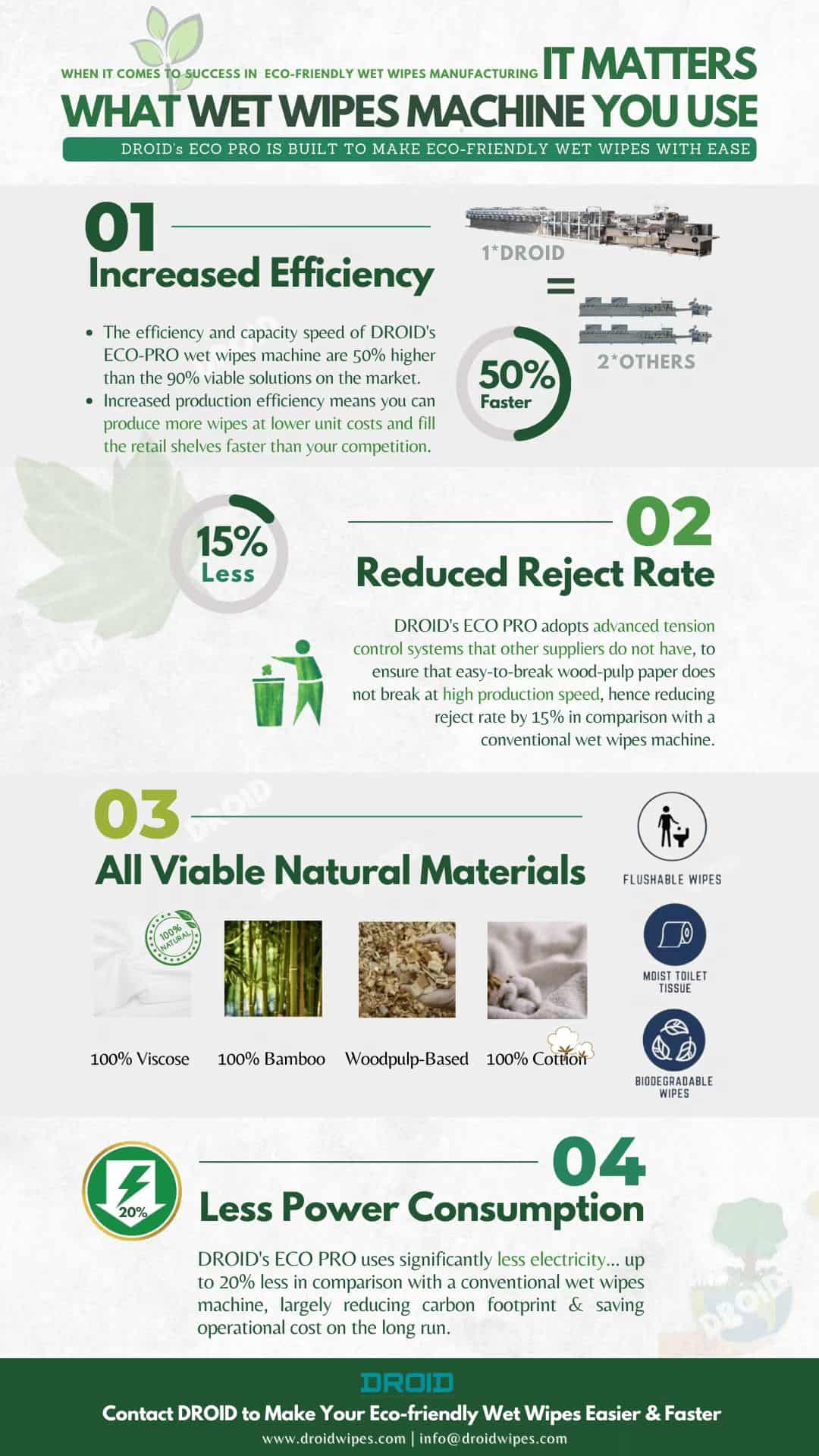1. Precision and Consistency: Minimizing Material Waste
Accuracy and uniformity are of utmost importance when it comes to the manufacture of wet wipes. Automated production lines outperform older human processes in several aspects, resulting in a substantial decrease in material waste. These sophisticated technologies are engineered to function with meticulous precision, guaranteeing that every wet wipe is manufactured according to exact requirements. This thorough focus on detail reduces the frequency of flaws and mistakes that often result in the wasting of materials.
Manual manufacturing procedures are naturally susceptible to variability. Human operators, while exerting their utmost efforts, are unable to attain the same degree of consistency as machines. Differences in the sizes of cuts, patterns of folding, and the use of solutions may result in substantial waste accumulation over some time. Automated systems, on the other hand, use advanced sensors and control mechanisms to ensure consistency. Every action, including the cutting, folding, and soaking of the wipes with cleaning solutions, is performed with meticulous accuracy, hence minimizing the probability of mistakes.
Additionally, the capacity to continuously manufacture wet wipes to the same exceptional level minimizes the need for reworking and rejecting. During manual procedures, if a batch of inferior wipes is produced, it may be necessary to dispose of them or subject them to further processing, resulting in the wastage of more raw materials and energy. Automated systems, on the other hand, generate a reduced number of faulty goods, preserving resources and improving overall production efficiency. This uniformity results in substantial cost reductions for producers and helps the promotion of more environmentally friendly operations.
Automation also enables enhanced quality control. Advanced automated systems may be outfitted with real-time monitoring and feedback loops that promptly identify and rectify deviations. For example, if a machine identifies that a wipe is being cut inaccurately, it may autonomously make necessary adjustments to rectify the problem without interrupting the manufacturing line. This feature enhances waste reduction by proactively resolving probable faults before they lead to the production of worthless items.
To summarize, the use of automation in the manufacturing of wet wipes introduces a heightened degree of accuracy and uniformity that cannot be achieved using human methods. Wet wipes manufacturers may attain environmental and economic advantages by reducing material waste via precise and consistent manufacturing. This innovation not only promotes sustainability objectives but also improves the profitability and dependability of the wet wipes manufacturing process.
2. Energy Efficiency: Optimizing Power Usage
Energy efficiency is a crucial element in ensuring the long-term viability of any wet wipes manufacturing process, including the manufacture of wet wipes. Automated production lines are designed to maximize power use, resulting in a substantial increase in energy efficiency compared to conventional manual techniques. This optimization not only decreases operating expenses but also mitigates the ecological consequences of manufacturing.
Automated systems use cutting-edge technology to guarantee equipment functions at its highest level of efficiency. Wet wipes machines equipped with variable-speed drives can modify their power consumption according to the individual demands of each stage of production. During moments of decreased demand or reduced workloads, the equipment can decrease its speed, resulting in a corresponding decrease in energy consumption. This flexibility stands in stark contrast to older, manual systems that often operate at maximum capacity regardless of the actual production requirements, resulting in superfluous energy use.
Another crucial element of the energy economy in automated wet wipes manufacturing is the integration of automatic shut-off capabilities. These systems can shut down or go into standby mode while they are not being used, therefore saving further energy. This is especially advantageous during intervals, maintenance intervals, or any period of inactivity, guaranteeing that no energy is squandered while the manufacturing line is not in use. In contrast, manual procedures may need equipment to remain operational even when not actively generating, leading to increased energy inefficiency.
The design of contemporary automated equipment also has a substantial impact on improving energy efficiency. These devices are often constructed using energy-efficient components and materials that decrease total power use. Instances of reduced energy consumption may be seen via the use of high-efficiency motors, LED lights, and enhanced insulation. Moreover, the use of regenerative braking systems, which effectively catch and recycle energy that is generally wasted during deceleration, significantly improves the energy efficiency of automated manufacturing lines.
Furthermore, the accuracy and velocity of automated systems lead to reduced production cycles, resulting in decreased energy consumption over time. Automated equipment enhances production efficiency by reducing the time and energy needed for each unit of production via faster and more precise job completion. The effectiveness of this efficiency becomes more apparent when expanding operations to meet increased demand since the total energy savings might be significant.
Furthermore, the use of intelligent technologies and data analysis in automated systems enables the ongoing surveillance and enhancement of energy consumption. Sensors and Internet of Things (IoT) devices can offer instantaneous data on energy use, allowing manufacturers to rapidly detect inefficiencies and perform necessary remedial actions. AI-driven predictive maintenance may anticipate future problems that may result in energy inefficiency, guaranteeing the machinery’s optimum operational state.
To summarize, the transition to automated manufacture of wet wipes results in substantial improvements in energy efficiency. Automated systems use modern technology, intelligent design, and real-time monitoring to minimize power utilization, resulting in decreased operating costs and a smaller environmental impact. The advantages of automation make it not only a financially prudent investment but also a conscientious one for promoting sustainable production.
3. Improved Resource Management: Reducing Water and Chemical Use
Efficient allocation and use of resources is an essential element of sustainable manufacturing, especially in the manufacture of wet wipes, which heavily rely on water and chemicals. Automated production systems demonstrate exceptional performance in this domain by accurately managing and enhancing the use of these vital resources, resulting in substantial reductions in waste and environmental consequences.
Automated systems are fitted with advanced control mechanisms that guarantee the accurate application of water and chemicals. When humans do tasks manually, their irregular application may cause either excessive or insufficient utilization, resulting in uneven product quality and wasteful use of resources. Automation eradicates this unpredictability by using sensors and computerized controls to accurately distribute the quantities required for each manufacturing cycle. This level of accuracy guarantees that just the exact amount of water and chemicals required are used, minimizing excess and preserving precious resources.
There are several advantages to having such fine control. To begin with, decreasing water use in the manufacturing of wet wipes is not only ecologically good but also economically profitable. The issue of water scarcity is becoming more significant on a worldwide scale, and enterprises that can reduce their water use are in a more advantageous position to operate sustainably. Automated systems do this by reusing water within the manufacturing process wherever feasible, using sophisticated filtration and purification technologies to maintain water quality without excessive consumption. This recycling capacity lowers the total need for new water, preserving this crucial resource.
Moreover, the meticulous use of chemicals in automated manufacturing lines has substantial environmental and safety consequences. The presence of some chemicals in wet wipes, including disinfectants and preservatives, might pose a threat to the environment if not handled appropriately. Automated methods guarantee the effective and accurate use of these compounds, hence reducing the likelihood of excessive application that may result in environmental pollution. In addition, producers may decrease their production expenses and enhance worker safety by minimizing the usage of chemicals, hence lowering the risk of exposure to potentially dangerous compounds.
Automation facilitates enhanced tracking and monitoring of resource use. Utilizing advanced data analytics and Internet of Things (IoT) devices, manufacturers may get immediate and precise information on water and chemical use. This enables them to promptly detect and address any inefficiencies in their processes. Attaining this degree of visibility and control is difficult in manual operations since correctly monitoring resource use is more problematic. By using these technologies, firms may continuously improve their operations, resulting in less resource use and improved sustainability.
Moreover, automated systems can be designed in a way that allows them to adapt and react to unique production requirements in real time. During times of decreased demand, the system can decrease the amount of water and chemicals being used, which helps to save resources without affecting the quality of the output. The capacity to adapt is essential for ensuring efficiency and sustainability under different production settings.
To summarize, the introduction of automated production systems in the wet wipes business leads to significant improvements in resource management. Through meticulous regulation of water and chemicals, these systems effectively minimize waste and environmental harm while simultaneously improving operational efficiency and cost efficiency. With the increasing need for sustainable industrial methods, automation emerges as a crucial approach to enhance resource management and promote a more environmentally friendly future.
4. Reduced Emissions: Cleaner Production Processes
Automated production methods in the wet wipes business provide substantial benefits by minimizing emissions, hence promoting cleaner and more sustainable manufacturing processes. These systems use modern technology and precise engineering to reduce the environmental effects of manufacturing operations. This aligns with worldwide initiatives to address climate change and promote sustainability.
Enhanced energy efficiency is a key method by which automated systems effectively decrease emissions. Automated equipment is designed to maximize power use, functioning at its highest level of effectiveness and minimizing superfluous energy consumption. Contemporary automated systems often have energy-efficient characteristics like variable speed drives and automatic shut-off capabilities, guaranteeing that the wet wipes machines use power only when necessary. The decrease in energy use immediately results in reduced greenhouse gas emissions, since there is a reduced reliance on power sources derived from fossil fuels.
Automated systems not only enhance energy efficiency but also mitigate air pollution by minimizing the emission of volatile organic compounds (VOCs) and other harmful pollutants. Conventional manual procedures often include the use of solvents and chemicals that have the potential to volatilize into the atmosphere, so exacerbating air pollution and posing health risks to workers. Automated systems can accurately regulate the application and containment of these compounds, hence reducing their emission into the atmosphere. Advanced filtration and ventilation systems improve this ability by catching and neutralizing airborne pollutants before their release into the surroundings.
Integrating automation into the manufacture of wet wipes also facilitates the use of more environmentally friendly technologies and procedures. Automated systems may include environmentally friendly alternatives, like as UV disinfection or ozonation, to replace traditional chemical treatments. These options generate less toxic byproducts. These solutions not only decrease emissions but also enhance the overall safety and environmental impact of the industrial process.
Furthermore, automation enables more effective waste management techniques, hence decreasing emissions. Automated sorting and recycling systems effectively segregate recyclable materials from garbage, guaranteeing a higher percentage of material reuse rather than resorting to incineration or landfill disposal. Incineration and landfill disposal are major contributors to greenhouse gas emissions, namely methane, which is a very powerful gas that contributes to climate change. Automated systems play a crucial role in reducing waste and increasing recycling, hence leading to less emissions and a more environmentally friendly production cycle.
Another crucial factor in reducing emissions in automated wet wipes manufacturing is the possibility of localizing supply chains. Automated systems provide enhanced efficiency and scalability in manufacturing, enabling producers to create production facilities in closer proximity to their target markets. This localization minimizes the need for transporting raw materials and completed goods across large distances, hence mitigating a significant contributor to carbon emissions. Reducing the length of supply chains results in decreased emissions from trucks, ships, and aircraft, hence amplifying the environmental advantages of automation.
In addition, the accuracy and uniformity of automated systems result in fewer production mistakes and less rework, which are major contributors to emissions in conventional manufacturing processes. Minimizing flaws and mistakes decreases the need for extra manufacturing runs, leading to decreased total energy consumption and emissions.
To summarize, the transition to automated production systems in the wet wipes business has significant advantages in terms of less emissions and more environmentally friendly manufacturing methods. Automation contributes to the creation of a more sustainable and environmentally friendly production environment by minimizing energy use, increasing air quality, adopting cleaner technologies, strengthening waste management, and localizing supply chains. These innovations not only aid in the worldwide effort to combat climate change but also establish manufacturers as responsible and forward-thinking leaders in their field.
5. Enhanced Recycling Capabilities
The use of automation in the manufacture of wet wipes greatly improves recycling capacities, leading to major environmental advantages and aligning with the concepts of a circular economy. Automated systems are fitted with cutting-edge technology that optimizes the recycling process, enhancing its efficiency and effectiveness.
Automated sorting devices are essential for enhancing recycling endeavors. These systems use sensors, cameras, and artificial intelligence to accurately detect and segregate recyclable items from garbage. Automated technologies provide the precise identification and processing of recyclable products by effectively sorting recyclables. This level of accuracy minimizes the pollution of recycling streams, a prevalent issue in manual sorting procedures. When recycling streams are contaminated, whole batches may be rejected, leading to an increase in the amount of garbage that is ultimately disposed of in landfills. Automation addresses this problem by guaranteeing cleaner and more refined recycling results.
Automation offers the notable benefit of seamlessly incorporating recycling into the manufacturing process. Automated systems can recycle waste materials directly at the location, hence minimizing the need for external recycling facilities and transportation. As an example, leftover pieces and faulty items might be subjected to reprocessing and then used again in the manufacturing process. This not only decreases trash but also lowers the carbon footprint linked to transporting recyclable items to off-site facilities.
Automation facilitates the more effective use of recyclable resources in the manufacturing of wet wipes. State-of-the-art equipment is capable of processing a greater percentage of recycled fibers and materials without sacrificing the quality of the final product. This feature enables the use of post-consumer recycled (PCR) material, which is essential for decreasing the need for new resources. Manufacturers may reduce their environmental effects and promote resource conservation by integrating recycled materials into their new goods.
Moreover, automated systems can streamline closed-loop recycling operations. Within a closed-loop system, the process involves the collection, recycling, and reintroduction of materials derived from used wet wipes back into the manufacturing cycle. This strategy greatly decreases waste and advocates for the sustainable use of resources. Automation improves the practicality of closed-loop systems by guaranteeing that the recycling process is effective, adaptable, and capable of upholding high-quality criteria.
Automated recycling solutions not only improve efficiency but also result in cost savings for producers. Reduced waste disposal expenses, reduced material expenses via the use of recycled inputs, and diminished energy usage all contribute to a more cost-effective manufacturing process. The savings may be used to invest in more sustainability efforts, which will create a positive feedback loop that promotes ongoing improvement in environmental performance.
Furthermore, automated recycling systems have a greater capacity to adjust to evolving legislation and market needs compared to manual procedures. With the growing emphasis on sustainability from both governments and customers, manufacturers are required to adhere to more stringent recycling regulations and showcase their dedication to environmental stewardship. Automated systems provide the necessary adaptability and expandability to fulfill these changing demands, guaranteeing that the wet wipes manufacturers stay under regulations and maintain competitiveness.
Furthermore, the use of automation to expand recycling capacities not only provides practical advantages but also enhances the public view of makers of wet wipes. As customers become more aware of environmental issues, they are more inclined to back firms that exhibit a strong dedication to sustainability. Wet wipes manufacturers may improve their brand image and attract environmentally conscious customers by investing in cutting-edge recycling technology.
Ultimately, the use of automation in the manufacturing process of wet wipes greatly enhances the ability to recycle them. Automated procedures minimize waste, mitigate environmental effects, and promote a circular economy by using improved sorting techniques, on-site recycling, the use of recycled materials, and the establishment of closed-loop systems. Automation in the wet wipes business is not only beneficial for the environment, but it also helps save costs, ensures compliance with regulations, and improves brand impression. These improvements make automation an essential approach to achieving sustainable production.
6. Streamlined Supply Chain: Lower Carbon Footprint
Implementing automation in the manufacturing of wet wipes not only improves productivity inside the plant but also greatly simplifies the supply chain, resulting in a reduced carbon footprint. Automated solutions enhance the sustainability and eco-friendliness of the production process by optimizing different phases of the supply chain.
Automation significantly enhances the efficiency of the supply chain by optimizing production planning and inventory management. Automated systems use advanced algorithms to properly forecast demand, plan production schedules, and effectively control inventory levels. This level of accuracy guarantees the effective ordering and use of raw materials, hence decreasing the need for unnecessary stockpiling and minimizing waste. Manufacturers may prevent overproduction and the resulting carbon emissions by carefully matching production with demand. This approach eliminates the need to produce, store, and dispose of extra items.
Automation facilitates the ability to produce goods and services on a smaller, more localized scale. Wet wipes manufacturers may establish manufacturing facilities in closer proximity to their consumers without compromising efficiency or product quality, thanks to advanced automated technology. This localization minimizes the need for transporting raw materials and completed items across great distances, hence reducing a substantial amount of carbon emissions. Reducing the length of supply chains leads to a decrease in emissions from trucks, ships, and aircraft, so directly contributing to a smaller carbon footprint. In addition, the use of localized manufacturing may result in faster response times and the availability of fresher items for customers, therefore improving the overall quality of service.
Another crucial element of automating supply chain optimization is the mitigation of transportation inefficiencies. Automated systems enhance logistics management by efficiently optimizing routes and load capacities. Automated warehouse management systems may optimize truck loading to maximize capacity, hence minimizing the required number of trips for transporting products. Additionally, these systems can strategize the optimal routes by considering variables such as traffic, road conditions, and delivery timetables. This results in reduced fuel use and emissions.
Furthermore, automated manufacturing systems can be seamlessly integrated with advanced real-time tracking and monitoring technology. This integration offers producers comprehensive visibility on the movement and state of commodities across the supply chain. Using this data, manufacturers may pinpoint bottlenecks, inefficiencies, and areas that need improvement. If a certain transportation route routinely experiences delays and higher fuel consumption, the system may propose alternate routes or techniques to optimize the process. This amount of transparency and authority aids in minimizing inefficiency, decreasing pollution, and improving the overall effectiveness of the supply chain.
Automated methods facilitate the adoption of sustainable packaging alternatives. Automated packaging machines may be configured to use environmentally friendly materials and optimize packing dimensions to minimize waste and enhance transportation efficiency. Wet wipes manufacturers may reduce the energy needed for transportation and lessen the carbon impact by decreasing the volume and weight of packing. In addition, automated solutions may promote the use of packaging that can be reused or recycled, thereby supporting wider sustainability objectives.
Moreover, the incorporation of renewable energy sources with automated systems may enhance the environmental advantages. Factories that are outfitted with solar panels, wind turbines, or other renewable energy technologies can operate automated equipment using clean energy. This leads to a substantial decrease in the carbon footprint of the whole manufacturing process. This integration promotes a more sustainable supply chain by ensuring that energy usage at each level is optimized for environmental friendliness.
To summarize, the use of automation in the manufacture of wet wipes results in an optimized supply chain, leading to a substantial reduction in the carbon footprint. Automated systems promote supply chain efficiency and sustainability by implementing enhanced production planning, localized manufacturing, optimal transportation, real-time tracking, sustainable packaging, and the use of renewable energy. These technological improvements not only help in preserving the environment but also provide economic advantages by decreasing operating expenses and improving the ability of the supply chain to withstand and respond to challenges. Wet wipes manufacturers may attain a more sustainable and efficient supply chain by using automation, therefore satisfying the increasing need for environmentally conscious goods.
7. Sustainable Packaging Solutions
Implementing sustainable packaging solutions is essential for minimizing the environmental consequences associated with the manufacture of wet wipes. Automation is crucial in facilitating these solutions, enabling wet wipes manufacturers to embrace environmentally friendly methods that reduce waste and encourage the use of renewable resources. Wet wipes manufacturers may attain substantial sustainability improvements and maintain product quality and efficiency by using automated packaging technologies.
An important advantage of automated packaging systems is their capacity to accurately regulate the quantity and composition of packaging materials used. Conventional manual packing procedures often lead to the excessive use of resources as a consequence of inconsistencies and mistakes made by humans. Automated systems use sophisticated sensors and algorithms to guarantee that each product is packed with the precise quantity of material necessary, hence minimizing waste. Precision is crucial when it comes to wet wipes since they typically need specialized packaging to preserve their wetness and uphold hygiene standards.
Automated packaging machines also enable the use of environmentally friendly materials, such as biodegradable polymers, recycled paper, and compostable films. These materials have a reduced environmental footprint in comparison to traditional plastics, which are sourced from finite fossil fuels and may take decades to break down. Automated systems can efficiently manage these sustainable materials, guaranteeing accurate and constant application. This feature not only decreases the environmental impact of the packaging but also satisfies the increasing customer need for environmentally friendly items.
Automated methods may also enhance package designs to decrease waste, in addition to material selection. Wet wipes manufacturers may use computer-aided design (CAD) tools to develop packaging that minimizes material usage while maintaining sufficient protection and performance. Automated methods may generate packaging sheets that are both thinner and stronger, minimizing material consumption while maintaining the product’s integrity. This optimization results in a decrease in the total volume and weight of packaging, which in turn leads to reduced transportation costs and emissions.
Moreover, automation facilitates the use of cutting-edge package forms that promote sustainability. Automated technology may create packaging that has built-in features like resealable closures or dispensing systems, which eliminate the need for extra packaging parts. These characteristics not only improve customer convenience but also reduce waste by ensuring that the product stays usable for a longer duration. In addition, automation may facilitate the creation of bulk packaging alternatives that minimize the need for individual packing, hence reducing waste and resource use even further.
Automated packaging solutions possess the notable capability to seamlessly incorporate into recycling and waste management procedures. Automated systems may be configured to effectively categorize and segregate packaging trash, guaranteeing the appropriate processing and reuse of recyclable materials. This integration facilitates a circular economy, whereby resources are perpetually recycled and reintroduced into the manufacturing process instead of being discarded in landfills. Automated methods aid in recycling, hence mitigating the environmental consequences of packaging waste and preserving natural resources.
Additionally, automated packaging systems may be engineered to minimize energy use while carrying out the packing procedure. Energy-efficient components, such as LED lights, variable speed motors, and controlled shut-off mechanisms, guarantee that packing equipment functions with little energy use. This decrease in energy use reduces the environmental impact of the packaging process and helps achieve broader sustainability objectives. In addition, factories may optimize energy efficiency by using renewable energy sources, such as solar or wind power, to power automated systems.
Furthermore, the use of automated systems enables producers to adhere to ever more rigorous environmental norms and requirements. Global governments and regulatory agencies are implementing more stringent mandates regarding packaging waste and sustainability. Automated packaging solutions facilitate compliance with laws by guaranteeing that packaging materials and procedures conform to the most stringent environmental criteria. Adhering to compliance not only helps to prevent possible fines and penalties but also improves the reputation of the business and fosters trust among consumers.
Ultimately, the use of automation in sustainable packaging solutions has notable ecological and financial advantages for makers of wet wipes. Automated packaging systems contribute to a more sustainable and efficient manufacturing process by exerting precise control over material use, improving package designs, introducing novel features, integrating with recycling operations, and decreasing energy consumption. Adopting these solutions is crucial for wet wipes manufacturers that want to decrease their environmental impact and fulfill the increasing need for eco-friendly goods.








